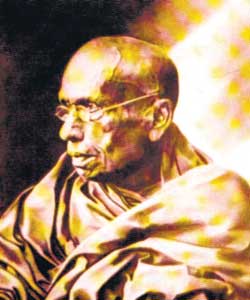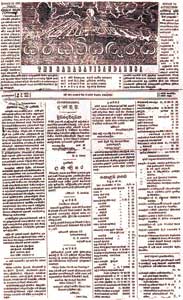A seat of Buddhist learning is born
At a time when the missionaries were very active spreading Christianity in our country, a few Sinhalese Buddhist leaders in Colombo met and discussed the plight of the people and were looking for ways and means of protecting the nation, the religion and the language. Having heard of an erudite monk residing in a temple at Hikkaduwa down South, they decided to meet him and invite him to come to Colombo and start a Buddhist educational institution.
The monk, Hikkaduwe Sri Sumangala Nayaka Thera who was residing at Tilakaramaya in the coastal town accepted their invitation. The group of 13, led by Don Philippu Silva, Epa Appuhamy and Mudaliyar Don Carolis Hewavitarana bought a block of land at Maligakanda, Maradana and put up a building to start the institution. Thus was born the Vidyodaya Pirivena on December 1, 1873.
Vidyodaya Pirivena was primarily meant as a place of learning for the Buddhist monks. Lay students could also follow classes which dealt mainly with oriental languages and Buddhism. The name of the monk was well-known not only in Sri Lanka but in other countries as well. Thus many laymen came over to join the Pirivena and learn the Dhamma and the Pali language. Even subjects like Astrology and Ayurveda, the native science of medicine were taught. Among the foreign students were many from Tibet, Japan, India, Siam (Thailand), Burma (Myanmar), Cambodia and China.
Soon young monks well versed in the Dhamma, were establishing temples in numerous places in the island. The Buddhists were thus able to learn the Dhamma and young monks in turn followed classes and gathered knowledge in the Pirivenas they set up at village level.
Vidyodaya Pirivena flourished as one of two Buddhist seats of learning, the other being Vidyalankara Pirivena, established by Ratmalane Dharmaloka Nayaka Thera in 1875. On January 1, 1959, both institutions were upgraded to university status on the initiative of the then Prime Minister,
S. W. R. D. Bandaranaike and the Education Minister, W. Dahanayake.
The name Vidyodaya was later changed to Sri Jayawardenapura while Vidyalankara became Kelaniya University,
indicating the locations of the two. Meanwhile the Vidyodaya Pirivena continues at Maligakanda just as Vidyalankara Pirivena continues at Peliyagoda, Kelaniya where it was first established. |


